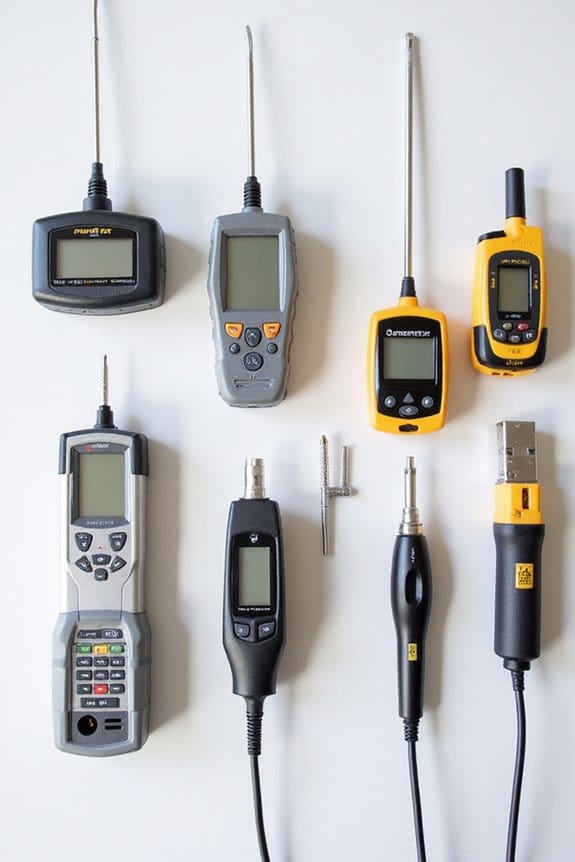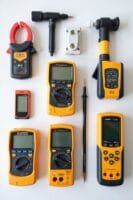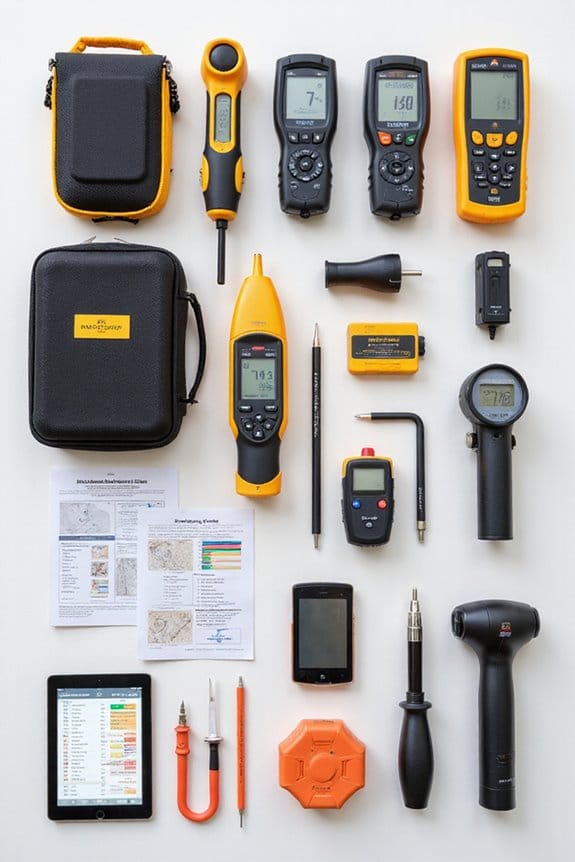When it comes to wood moisture meters, accuracy can really vary. Quality meters give precise measurements within 0.1%, while cheaper ones can differ by 5% to 20%. Calibration is key, especially for different wood species; an uncalibrated meter could lead to big errors. For best results, make sure your meter’s set right for what you’re measuring. Curious about which type of meter suits your needs? Stick around, and I’ll share some insider tips!
Key Takeaways
- High-quality wood moisture meters measure accuracy within 0.1%, while cheaper options can vary by 5% to 20%.
- Proper calibration for specific wood species is crucial to avoid errors of 2% or more.
- Environmental conditions and wood grain orientation can significantly affect moisture readings.
- Pin-type meters are accurate but may damage wood, while pinless meters provide non-destructive surface measurements.
- Taking multiple readings and ensuring clean surfaces improves overall measurement precision.
Understanding Wood Moisture Meter Accuracy
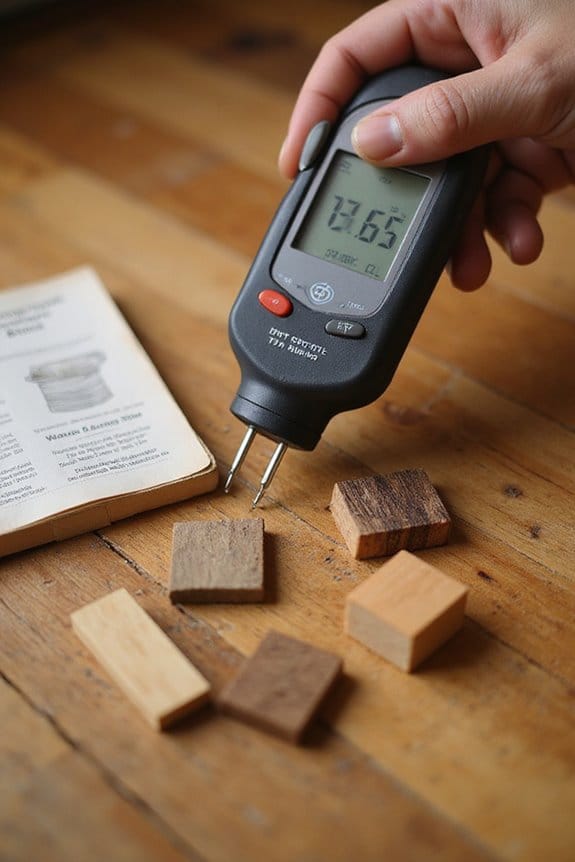
When it comes to understanding wood moisture meter accuracy, it’s important to realize that not all meters are created equal. Here are some key points to examine:
- Accuracy Levels: High-quality meters can measure within 0.1%, while cheaper ones may vary by 5% to 20%. Yikes, right?
- Calibration Techniques: Proper calibration tailored to wood species is essential. Incorrect calibration can lead to errors of 2% or more.
- Measurement Standards: Accuracy is often judged against the oven-dry test, the gold standard for moisture content.
- Consistency: Quality meters deliver reliable and repeatable results. Inaccurate readings can really mess up your projects!
- Versatility in Materials: Many high-quality meters are designed for multiple materials such as wood, drywall, and concrete, which enhances their overall utility.
Factors Influencing Measurement Precision
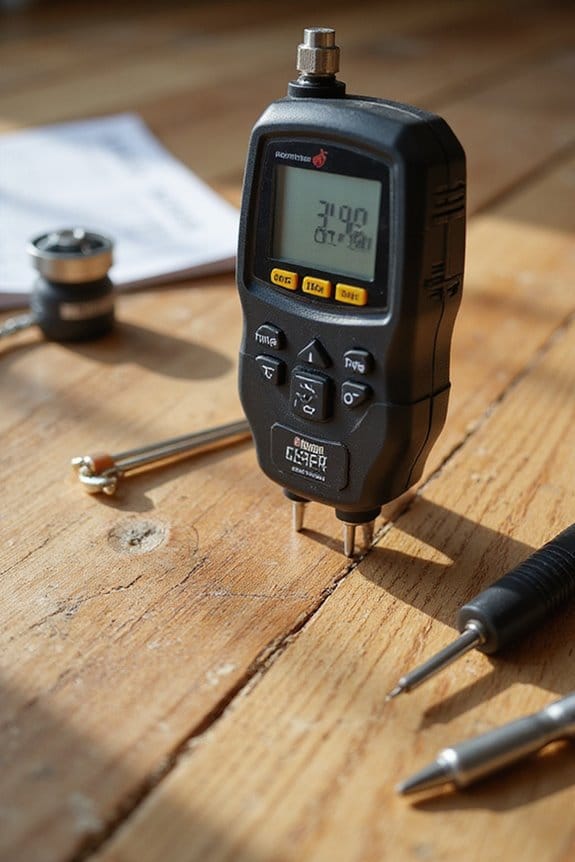
Accurate measurements are essential for any woodworking project, and several factors can influence that precision. Here’s what I’ve found:
- Wood Species: Different species have unique densities affecting moisture absorption and meter readings. Calibration settings should match the species for better accuracy.
- Grain Orientation: The direction of the grain can impact moisture distribution, leading to inconsistent readings.
- Environmental Conditions: Temperature changes affect electrical resistance in wood, so it’s crucial to measure under stable conditions.
- Surface Preparation: Clean, dry surfaces yield more reliable results than weathered or sealed ones.
- External Interferences: Metal fasteners or contaminants can skew readings, so keep an eye out!
- Sensor Characteristics: The type of meter influences accuracy. Regular calibration helps maintain precision, and choosing the right meter with multiple measurement modes can enhance overall performance.
Different Types of Wood Moisture Meters
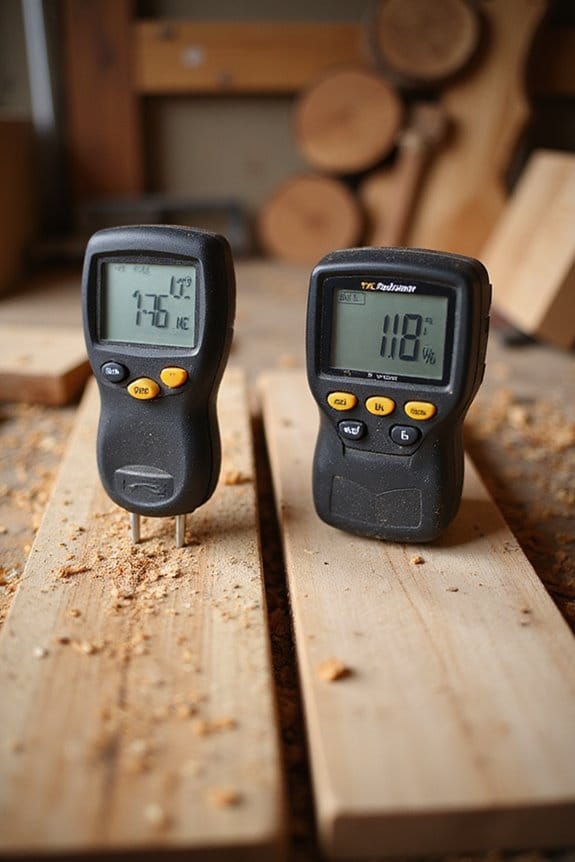
Understanding the different types of wood moisture meters can really enhance your woodworking experience. Here’s a quick rundown:
- Pin-Type Meters: These use metal pins to measure moisture by penetrating the wood. They’re super accurate for internal moisture but can leave tiny holes. Perfect for carpenters needing precise readings!
- Pinless Meters: These guys use electromagnetic sensors to scan the surface without damaging it. They’re great for quick checks on finished wood, though they might not reach deep moisture.
- Combination Meters: Why choose? These offer both pin and pinless capabilities, making them versatile for various tasks.
In my experience, knowing the right meter for your project can save you time and headaches. Trust me, it’s worth it! Additionally, pinless meters typically offer non-destructive measurement methods that allow for surface and subsurface moisture detection without damaging the wood.
The Impact of Quality and Price on Accuracy

While it might seem tempting to grab the cheapest wood moisture meter you can find, the truth is that quality and price play a huge role in accuracy. Here’s why:
- Accuracy Levels: High-quality meters can achieve accuracy within 0.1%, while cheaper ones might range from 5% to 20%. That’s a big difference!
- Sensor Performance: Better sensors lead to more reliable readings. Premium meters use advanced technology for consistent results.
- Calibration Techniques: Quality devices offer tailored calibration for various wood species, which helps in getting precise measurements. Poorly calibrated meters can lead to significant errors.
In my experience, investing in a decent meter pays off. Trust me, you don’t want to rely on fluctuating readings when it comes to moisture content! Additionally, proper maintenance tips can further enhance the lifespan and accuracy of your moisture meter.
Best Practices for Accurate Moisture Readings

When it comes to getting reliable moisture readings, following best practices can make all the difference. Here are some tips I’ve found helpful:
- Verify Calibration: Always check your meter against a known standard, rather than just trusting built-in tests. Calibration techniques matter!
- Account for Wood Species: Different woods can skew readings. Adjust your meter settings according to the species you’re measuring.
- Use Proper Technique: Confirm the sensor fully contacts the wood. Avoid defects that can give misleading results.
- Control Environment: Measure in stable conditions and make certain the wood surface is dry.
- Take Multiple Readings: This helps you get an average for better measurement precision. Additionally, remember that measurement accuracy is crucial to prevent mold growth and structural damage.
Comparative Analysis of Meter Accuracy Levels
As I plunge into the world of wood moisture meters, it’s essential to realize just how varied their accuracy levels can be. Here’s a quick comparison for you:
- High-Quality Meters: These can achieve accuracy within 0.1%. They’re built with precision and calibrated against the oven-dry test—definitely for pros needing reliable readings.
- Lower-Grade Meters: Watch out! Their accuracy can swing wildly from 5% up to 20%. This means you might get misleading results, making them best for rough estimates only.
- Pin-Type vs. Pinless: Pin-type meters are generally more accurate, especially for localized readings, while pinless meters can struggle with mixed materials.
In my accuracy testing, remember: brand reputation and build quality make a huge difference! Choose wisely!
Recommendations for Choosing the Right Meter
Choosing the right wood moisture meter can feel overwhelming, especially with so many options out there. Here are my top recommendations to help you make a smart choice:
- Consider Meter Features: Look for models with adjustable moisture ranges and species settings. If you’re working with different wood types, this is essential!
- User Experience: Opt for meters with backlit displays and clear readouts. You want something easy to use, especially when you’re knee-deep in a project.
- Budget: While a $39 meter might get the job done for basic needs, investing in a more expensive model can pay off in accuracy and durability.
- Type Matters: Pin meters are great for deeper readings, while pinless meters are perfect for surface moisture. Choose based on your typical wood thickness.
Happy measuring!
Frequently Asked Questions
How Do I Maintain My Wood Moisture Meter for Accuracy?
I’ve found that proper calibration techniques and regular maintenance tips are essential for keeping my wood moisture meter accurate. I always check it after drops, clean the pins, and replace batteries as needed.
Can I Use a Moisture Meter on Different Wood Species?
Absolutely, I can use a moisture meter on different wood species. Just remember, accurate moisture measurement relies on knowing the specific wood type and ensuring the meter’s calibration is suitable for that species.
What Is the Typical Lifespan of a Wood Moisture Meter?
Imagine a trusty tool, weathered yet reliable; my wood moisture meter’s longevity often spans 5 to 10 years. Its durability hinges on care, protecting it from environmental extremes while ensuring it remains my steadfast companion.
Are There Any Specific Brands Known for Accuracy?
When considering brand comparisons, I’ve found that Proster and K-Timber consistently receive high accuracy ratings. They offer reliable moisture readings, especially when calibrated for specific wood types, making them great choices for precise measurements.
How Often Should I Calibrate My Moisture Meter?
I’ve learned that calibrating my moisture meter regularly is like tuning a fine instrument. Calibration frequency affects meter performance; I check it daily for heavy use, but monthly works well for lighter tasks. Always follow manufacturer guidelines!

